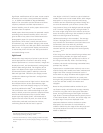
Standards for Measuring Stability
I
nternational standards for measuring the stability
of color materials are contained in the ANSI/ISO
S
tandard Stability of Color Photographic Images—
Methods for Measuring
, ANSI Publication IT9.9-1996
and ISO Publication 10977. An updated version of
this standard, ISO Publication 18909-2006, was
issued in 2006. Work currently under way in the
standards committee includes a new set of
publications to address the additional complexities
and degradation mechanisms found in non-silver
halide color materials.
A look thr
ough the current 60-page standard on
silver halide materials quickly reveals that the
testing and measurement of image stability is a very
complex science. The standard also provides
recommendations and guidance on interpreting and
using test data generated by the testing methods.
Why doesn’t the standard provide specific rules and
definitions on how to interpret the data? The
standard provides only general recommendations
and guidance because images in general have a wide
range of stability requirements based on intended
application, and are stored or displayed under a vast
range of conditions.
The standard strongly suggests that interpretation
of test data be based on the specific conditions
likely to be encountered as the product is used in
the real world. For example, the typical environment
for prints on SUPRA or SUPRA VC Digital ENDURA
Paper is a wall display or a wedding album kept in a
home. This is very different from the typical
en
vironment for prints on ENDURA Metallic Paper,
which is lik
ely to be a high-int
ensity point-of-
purchase commercial display in a mall. It is logical
that the int
erpr
etation of the imag
e-stability data
for these two very different products reflect the
different environments.
Design for Real-World Conditions
K
odak has long recognized the importance of
product design based on customer use. KODAK
P
ROFESSIONAL SUPRA and SUPRA VC Digital
ENDURA Papers are designed to be used by end-
consumers in the home. These papers are designed
for “portrait and social” applications, i.e., formal
portraits and wedding pictures displayed in a home
or stored in albums.
Remember the three major design criteria: image
quality, print life, and performance in the finishing
lab. In the case of papers for portrait and social
applications, pr
oduct design for print longevity,
without regard to real-world conditions and the
other two major design criteria, could result in many
trade-offs, even in print life itself. For example,
excellent high intensity light stability with mediocre
thermal stability would be a poor combination in
prints stored and displayed where light intensity is
low but thermal performance is significant.
Similarly, a trade-off in finishing lab operations—
such as permitting high sensitivity to chemical
activity levels to achieve good print life—would be a
poor choice.
KODAK PROFESSIONAL SUPRA and SUPRA VC
Digital ENDURA Papers are optimized for all three
major design criteria in the context of real-world
portrait/social applications. The design criteria for
KODAK PROFESSIONAL ULTRA and ENDURA
Metallic Papers are tailored to the needs of the
commercial display market.
Just as the design of KODAK PROFESSIONAL
ENDURA Papers reflects real-world conditions, any
testing and interpreting of stability data must also
reflect the environment in which the product will be
used and st
ored. Reporting of stability results for
por
tr
ait and social papers, like SUPRA and SUPRA
VC Digital ENDURA Papers, without regard to real-
w
orld c
onditions can mislead labs in their choic
e of
a color paper as well as photographers and
consumers in their choice of a finishing lab.
6
















